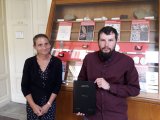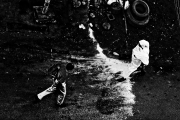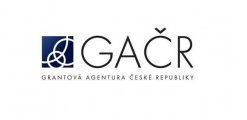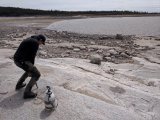News archive
News older than one year.
Research Reports 2018
Annual report on scientific activities of staff of the Institute of Geology – Research Reports 2018 – has been published.
Week of Science and Technology 2019
In mid November, the Institute of Geology participated in the 19th year of the Week of Science and Technology of the Czech Academy of Sciences. The all-time highest number of visitors, i.e., 220 guests, attended the traditional tours of selected laboratories within the Open Door Days. Most of them came from primary and secondary schools outside Prague. Those showing active interest received gifts, such as mineral and fossil samples or small souvenirs provided by the Centre for Joint Activities of the Academy of Sciences.
Besides traditional visits, the Institute of Geology participated in an escape game called “Global Natural Disasters” organized by the Centre for Joint Activities of the CAS in cooperation with the Institute of Chemical Process Fundamentals of the CAS. During the week, about 530 people, especially children, joined this game at the Institute of Geology. Some photos from the Week of Science and Technology at the Institute of Geology can be found here.
Filip Scheiner successful in defending Ph.D. thesis
On Friday 27th, Filip Scheiner successfully defended his Ph.D. thesis titled Geochemical markers from foraminiferal tests as a tool for reconstruction of paleoceanological environments: a case study from the Miocene of the Central Paratethys. His supervisor was Katarína Holcová of the Institute of Geology and Paleontology, Faculty of Science, Charles University. Congratulations!
Photogenic Science: Pavel Lisý awarded first prize in “free category”
On October 10, results of the Photogenic Science 2019 contest were announced. Pavel Lisý of the Institute of Geology CAS was awarded the first prize in “free category” with his photograph “Bílá roztahuje svoje sítě – The white spreads out its nets”. The project Photogenic Science was initiated by the collective “Fórum Věda žije!” with the aim to organize a yearly photographic contest for the staff of the Czech Academy of Sciences. The result of the project is a representative calendar with selected photographs and the Photogenic Science exhibition, which will be presented not only in Prague but also at other places in Czech Republic and abroad. The exhibition is accessible in the American Center in Lesser Town of Prague (Tržiště 366/1, Praha 1) by October 29, 2019.
Project contributed by the Institute awarded a Czech Science Foundation prize
The prize of the chairwoman of the Czech Science Foundation 2019 was awarded to five researchers of the best basic research projects completed last year. Jiří Bruthans of the Faculty of Science, Charles University received an award for the project titled “Effect of gravity-induced stress on sandstone erosion: physical and numerical modelling”. Co-applicants of this project were Michal Filippi of the Institute of Geology of the CAS and Jana Schweigstillová of the Institute of Rock Structure and Mechanics of the CAS. The winning projects were decided by the Presidium of the Czech Science Foundation among proposals by the relevant subject area commissions. This year, 5 projects were awarded (in the fields of chemistry, medicine, geology, zoology and sociology) of a total of 448 projects. The results of the awarded geological project were presented, for example, in the journals Geomorphology, Earth Surface Processes and Landforms, Earth-Science Reviews and Geology (including the title page). Congratulations on this success!
For additional details on prize winners and projects click here.
Field study of Late Archean granites (ca. 2.9–2.6 Ga) in northeastern Canada
A joint research group from the Institute of Geology CAS and Charles University returned from a field study of several geological transects across the James Bay area in northeastern Canada (province of Quebec). The team documented petrology and inner structures of several lithological types of plutonic and metamorphic rocks in the Bienville subprovince: Opinaca, La Grande and Opatica units. In this wilderness area, the team also collected a huge amount of rock material focusing especially on the analysis of internal pluton fabrics, including anisotropy of magnetic susceptibility (AMS), and metasediments for zircon geochronological U-Pb dating. Photos.
Director Tomáš Přikryl interviewed by the Týden magazine
In his interview for the Týden magazine (in Czech), Tomáš Přikryl covered the themes of discovering new animal species and a human impact on planet Earth.
Filip Tomek awarded the Otto Wichterle Prize
Prof. Eva Zažímalová, President of the Czech Academy of Sciences, decorated twenty-three young scientists with the Otto Wichterle Award in Lanna Villa in Prague on Wednesday, June 19, 2019. One of the Award holders was Mgr. Filip Tomek, PhD., a research scientist of the Institute of Geology of the Czech Academy of Sciences.
Joachim Barrande – 220 years of his birth
The distinguished French geologist and palaeontologist Joachim Barrande was born on 11 August 1799. His research work concentrated on Bohemia, starting in the 1830s. Barrande died at Frohsdorf (Austria) on 5 October 1883 and is buried in the cemetery at Lanzenkirchen. At the occasion of the 220 yearsʼ anniversary of his birth, director of the Institute of Geology together with representatives of the Paleontological Department of the National Museum and the Society of the National Museum paid tribute to this eminent researcher at his grave.
Lesní potok catchment under a magnifying glass
The last issue of the Academic Bulletin journal published for public relations of the Czech Academy of Sciences, No. 05/2019, features an interview with Tomáš Navrátil (in Czech). It is aimed at research of the experimental Lesní potok catchment in the Voděrady beechstands. This interview covers various aspects of small catchment monitoring and biogeochemical research in general.











